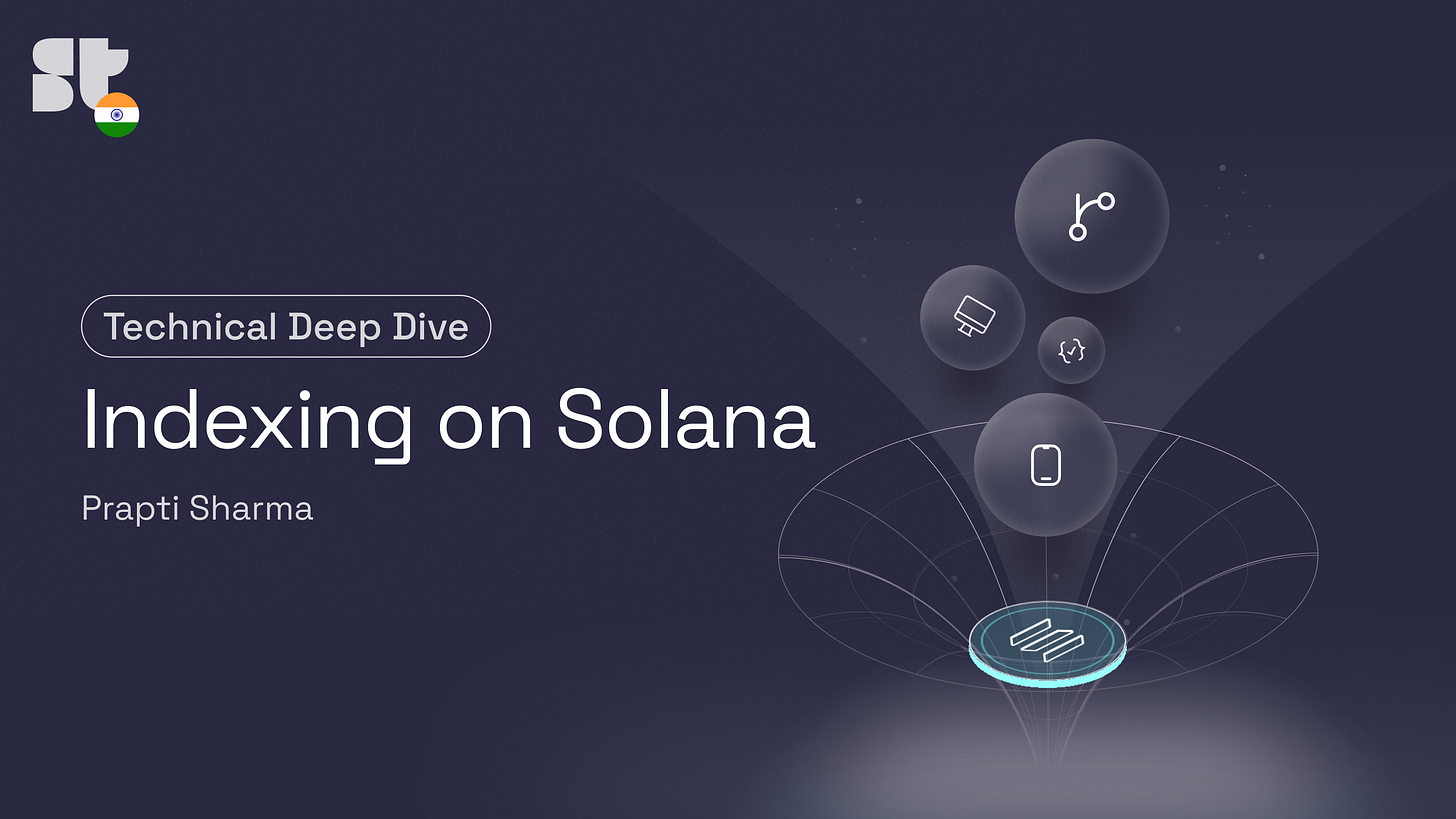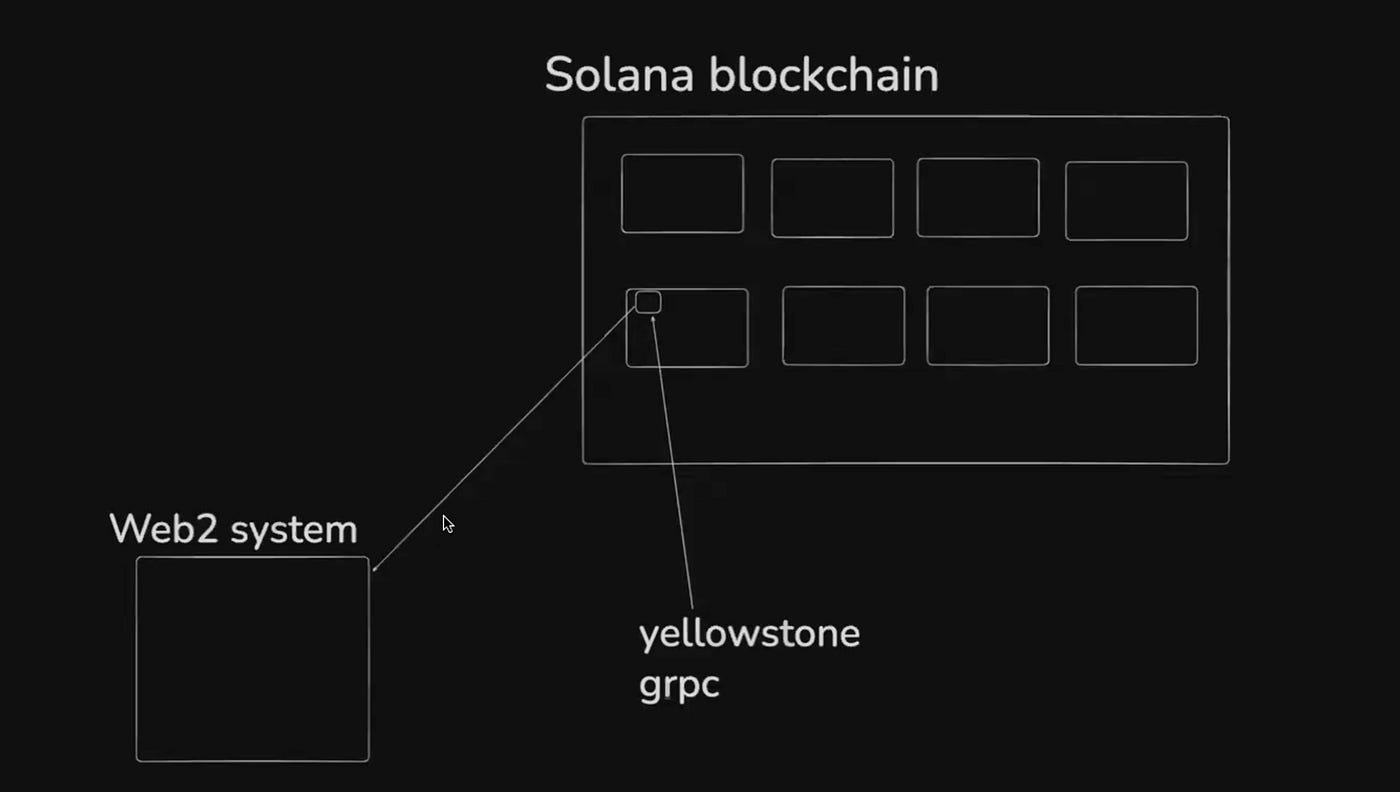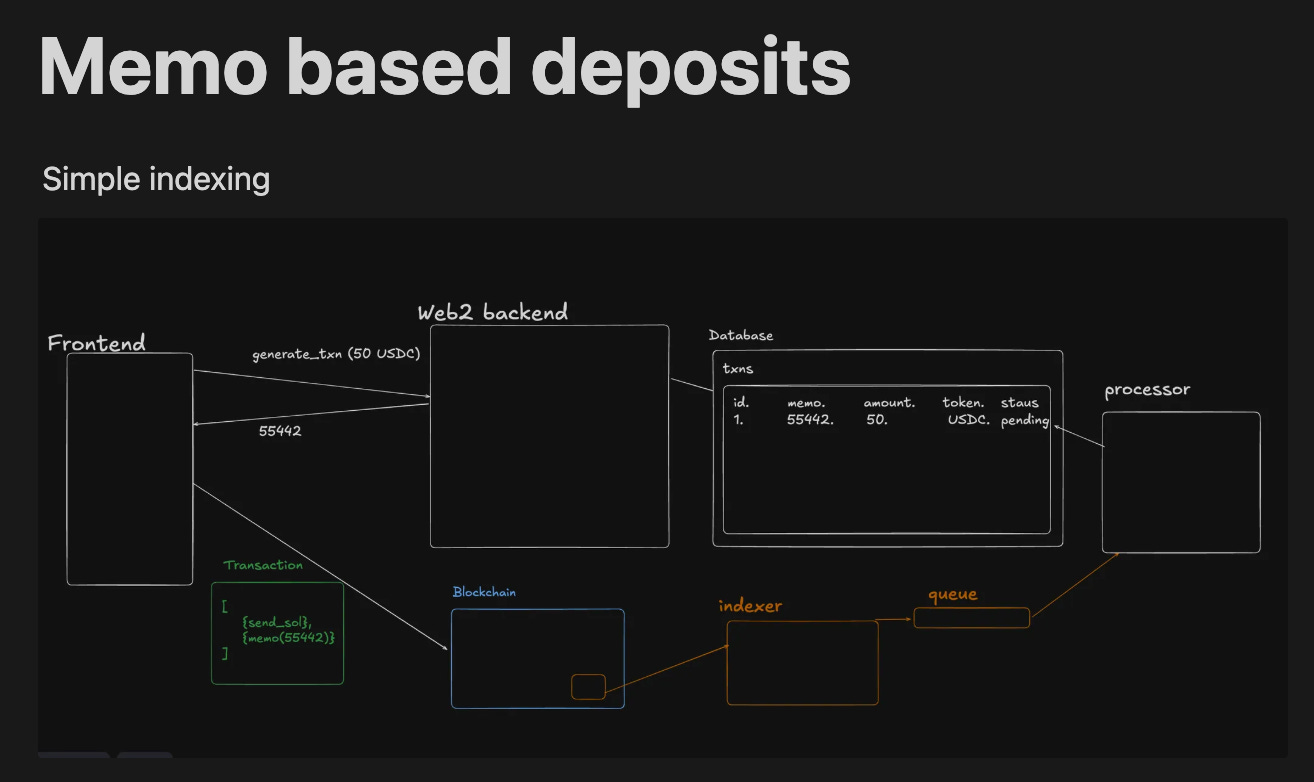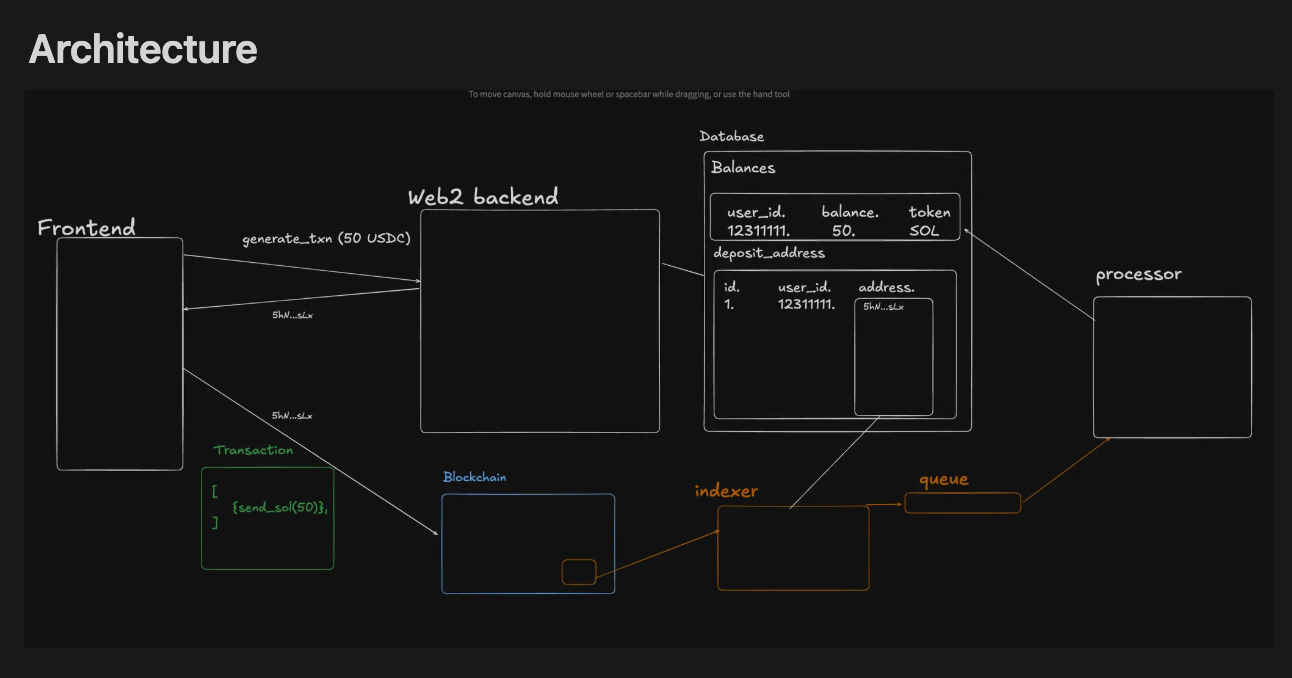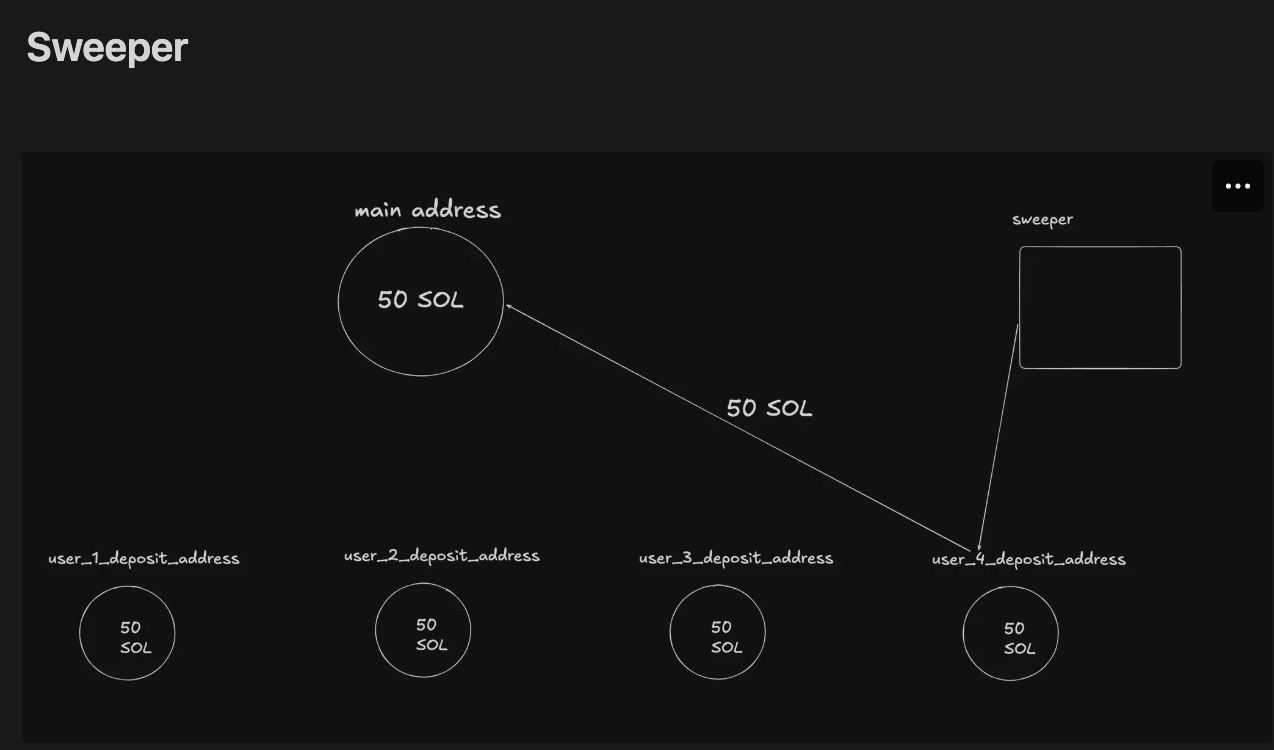Building payment infrastructure on Solana requires understanding how to properly index blockchain data for centralized applications. Whether we’re building a centralized exchange (CEX), crypto gateway, or e-commerce platform, indexing is the foundation that enables us to track user deposits, process withdrawals securely, and maintain accurate balances.
This comprehensive guide covers everything we need to know about Solana indexing, from basic concepts to advanced security considerations for production systems.
What is Indexing?
Indexing means copying over the state of a blockchain to a Web2 system. In the context of Solana, it involves extracting specific transaction data from the high-throughput blockchain and storing it in traditional databases like PostgreSQL or MongoDB.
The goal isn’t to copy the entire blockchain — that would be expensive and unnecessary. Instead, we focus on indexing specific addresses or transactions relevant to our application. For example, we might want to track:
All transactions to our exchange’s deposit address
Activity on specific liquidity pools
Transactions involving particular token contracts
User deposits and withdrawals
The Solana blockchain processes hundreds of transactions per second since Genesis, generating terabytes of data. Our indexing system needs to efficiently filter this stream to capture only the transactions we care about.
How to Index: Yellowstone & Geyser
The most robust approach to Solana indexing is using Yellowstone, built on top of the Geyser plugin. These tools allow us to subscribe to real-time blockchain events as they happen.
Understanding the Architecture
When validators on the Solana network receive transactions and create blocks, they can run additional processes (plugins) that extract and forward specific transaction data. Yellowstone provides a gRPC interface to these plugins, enabling us to:
Subscribe to specific accounts or programs
Filter transactions based on our criteria
Receive real-time updates as transactions are confirmed
Available RPC Providers
Several providers offer Yellowstone services:
Triton: Created Yellowstone, offers premium indexing services
Helios: Competitor with their own indexing tools
Quicknode: Provides RPC and indexing infrastructure
Alchemy: Web3 infrastructure provider
Pricing and Access
Free Yellowstone servers exist (like parafi.tech) but with limitations—typically only allowing subscriptions to predefined accounts like the vote program. For production use, expect to pay:
Shift.io: ~$200/month for one connection
Titan: ~$1000/month for premium access
Custom validators: Exchanges often run their own validators with Geyser plugins
The Problem with Naive Payment Flows
Before diving into proper indexing solutions, let’s understand why simple payment flows fail. Consider a basic e-commerce site selling t-shirts for 0.5 SOL:
Broken Flow:
User sends 0.5 SOL to our address
User’s client gets the transaction signature
Client forwards the signature to our backend
Backend verifies the signature and ships the product
Critical Problems:
1. Lack of Atomicity (Client Crash) If the user’s client crashes after step 1 but before step 3, the money is sent, but our backend never knows. The user loses their SOL with no product shipped.
2. Transaction Sniping (Impersonation) An attacker can monitor our payment address, grab any transaction signature, and claim it with their own session cookie before the real user can. Our backend has no way to verify who actually sent the payment.
The Solution: Memo Program + Indexing
Solana’s Memo Program (MemoSq4gqABAXKb96qnH8TysNcWxMyWCqXgDLGmfcHr) provides the solution. This program logs arbitrary strings on-chain, allowing us to attach identifiers to transactions.
Secure Architecture:
Frontend requests to make a purchase
Web2 Backend generates a unique identifier (random number or user ID) and returns it
Frontend constructs a transaction with TWO instructions:
system_program::transferto send SOL to our addressmemo_programcall with the unique identifierUser signs and sends this atomic transaction
Indexer (Yellowstone client) sees the transaction and parses the memo
The processor uses the identifier to credit the correct user
Implementation Example:
import {
Connection,
Keypair,
LAMPORTS_PER_SOL,
SystemProgram,
Transaction,
sendAndConfirmTransaction
} from "@solana/web3.js";
import { createMemoInstruction } from "@solana/spl-memo";
// Connect to Solana cluster
const connection = new Connection("http://localhost:8899", "confirmed");
// Create keypair for the fee payer
const feePayer = Keypair.generate();
// Request airdrop
const airdropSignature = await connection.requestAirdrop(
feePayer.publicKey,
LAMPORTS_PER_SOL
);
// Confirm airdrop
const { blockhash, lastValidBlockHeight } =
await connection.getLatestBlockhash();
await connection.confirmTransaction({
signature: airdropSignature,
blockhash,
lastValidBlockHeight
});
// Create transaction with transfer and memo
const memoInstruction = createMemoInstruction("Hello, World!");
const sendSolana = SystemProgram.transfer({
fromPubkey: feePayer.publicKey,
toPubkey: Keypair.generate().publicKey,
lamports: 0.5 * 1000_000_000
});
const transaction = new Transaction()
.add(sendSolana)
.add(memoInstruction);
// Sign and send
const transactionSignature = await sendAndConfirmTransaction(
connection,
transaction,
[feePayer]
);
console.log("Transaction Signature: ", transactionSignature);Why This Works:
Solves Atomicity: The indexer runs independently and will always see confirmed transactions
Prevents Sniping: Payment and user identifier are locked together in one atomic transaction
Cost-Effective: We can use simple RPC polling instead of expensive Yellowstone for single-address indexing
Required Memo Extension for Token Accounts
For enhanced security with token transfers, Solana offers the Required Memo extension. This ensures all incoming token transfers must include a memo.
Creating Token Account with Required Memo:
import {
TOKEN_2022_PROGRAM_ID,
getAccountLen,
ExtensionType,
createInitializeAccountInstruction,
createEnableRequiredMemoTransfersInstruction,
} from "@solana/spl-token";
export async function createTokenWithMemoExtension(
connection: Connection,
payer: Keypair,
tokenAccountKeypair: Keypair,
mint: PublicKey,
): Promise<string> {
// Create account instruction
const accountLen = getAccountLen([ExtensionType.MemoTransfer]);
const lamports = await connection.getMinimumBalanceForRentExemption(accountLen);
const createAccountInstruction = SystemProgram.createAccount({
fromPubkey: payer.publicKey,
newAccountPubkey: tokenAccountKeypair.publicKey,
space: accountLen,
lamports,
programId: TOKEN_2022_PROGRAM_ID,
});
// Initialize account instruction
const initializeAccountInstruction = createInitializeAccountInstruction(
tokenAccountKeypair.publicKey,
mint,
payer.publicKey,
TOKEN_2022_PROGRAM_ID,
);
// Enable required memo transfers instruction
const enableRequiredMemoTransfersInstruction =
createEnableRequiredMemoTransfersInstruction(
tokenAccountKeypair.publicKey,
payer.publicKey,
undefined,
TOKEN_2022_PROGRAM_ID,
);
// Send transaction
const transaction = new Transaction().add(
createAccountInstruction,
initializeAccountInstruction,
enableRequiredMemoTransfersInstruction,
);
return await sendAndConfirmTransaction(
connection,
transaction,
[payer, tokenAccountKeypair],
);
}Transferring to Required Memo Account:
const message = "Hello, Solana";
const transaction = new Transaction().add(
new TransactionInstruction({
keys: [{ pubkey: payer.publicKey, isSigner: true, isWritable: true }],
data: Buffer.from(message, "utf-8"),
programId: new PublicKey("MemoSq4gqABAXKb96qnH8TysNcWxMyWCqXgDLGmfcHr"),
}),
createTransferInstruction(
sourceAccount,
destinationAccount,
payer.publicKey,
transferAmount,
undefined,
TOKEN_2022_PROGRAM_ID,
),
);
await sendAndConfirmTransaction(connection, transaction, [payer]);const message = "Hello, Solana";
const transaction = new Transaction().add(
new TransactionInstruction({
keys: [{ pubkey: payer.publicKey, isSigner: true, isWritable: true }],
data: Buffer.from(message, "utf-8"),
programId: new PublicKey("MemoSq4gqABAXKb96qnH8TysNcWxMyWCqXgDLGmfcHr"),
}),
createTransferInstruction(
sourceAccount,
destinationAccount,
payer.publicKey,
transferAmount,
undefined,
TOKEN_2022_PROGRAM_ID,
),
);
await sendAndConfirmTransaction(connection, transaction, [payer]);Deposit Architecture Patterns
Pattern 1: Memo-Based Deposits (Recommended)
All users send funds to a single address with unique memo identifiers:
Advantages:
Simple to implement and maintain
Cost-effective indexing (can use simple RPC polling)
No private key management complexity
Perfect for most applications
Process:
User requests a deposit
Backend generates a unique seed/nonce, stores it in the database as ‘pending’
Frontend creates a transaction with transfer + memo containing the seed
Indexer monitors a single address and processes transactions
Processor matches memo to database record and updates user balance
Pattern 2: Unique Deposit Addresses (Binance-Style)
Every user gets their own unique deposit address:
Advantages:
Familiar to users from traditional exchanges
Clear separation of user funds
Easy to track individual user activity
Disadvantages:
Complex private key management for millions of addresses
Requires fund consolidation (“sweeper”) process
Higher gas costs for moving funds between addresses
More complex indexing (must monitor many addresses)
The Sweeper Problem
When using unique deposit addresses, funds get scattered across thousands of wallets. A sweeper process must periodically consolidate these funds:
Monitor all user deposit addresses for incoming funds
Calculate gas fees needed to move funds from each address
Send SOL to addresses that need gas for token transfers
Sweep funds from deposit addresses to the main treasury
Timing sweeps during low gas periods for cost efficiency
This complexity makes memo-based deposits preferable for most applications.
Withdrawal Architecture and Security
Withdrawals are the most critical and dangerous operations in any centralized crypto platform. Once funds leave our control, they cannot be recovered, making security paramount.
The Withdrawal Problem
When a user wants to withdraw 100 SOL from their 400 SOL balance:
The database shows that 400 SOL belongs to the user
The actual SOL sits in our centralized “hot wallet”
We must atomically reduce the user’s database balance AND send a blockchain transaction
Any failure in this process can result in lost funds or double-spending
Naive Withdrawal Flow (DANGEROUS):
app.post('/withdraw', (req, res) => {
// 1. Check user's balance (400 SOL)
// 2. REDUCE balance in DB (set to 300 SOL)
db.balances.update({ userId: 1, currency: 'SOL' }, { $inc: -100 });
// 3. Get MPCs to sign withdrawal transaction
const signature = MPC1.sign() + MPC2.sign() + MPC3.sign();
// 4. Send transaction to blockchain
connection.sendTransaction(signature);
});Critical Problems:
1. Database Before Blockchain
If we reduce the balance first, but the blockchain transaction fails (network issues, old blockhash), the user loses their funds in the database, but the money never leaves our wallet.
2. Blockchain Before Database
If the blockchain transaction succeeds but the database update fails (DB crash), the user receives their 100 SOL but still has 400 SOL in their account — they can withdraw again (double-spend).
3. Race Conditions
Multiple simultaneous withdrawal requests could all check the same balance, all see sufficient funds, and all proceed — allowing withdrawal of more funds than available.
Robust Withdrawal Implementation
Queue-Based Processing
The solution is using a message queue system (like Kafka) for sequential processing:
API Endpoint validates the request and places it in the withdrawal queue
Single Worker process pulls requests one by one:
Checks and locks the user’s balance
Creates and signs a transaction
Sends transaction to blockchain
Updates the database on confirmation
Acknowledges the queue message
Idempotent Withdrawals
To handle worker crashes, we must make withdrawals idempotent (safe to retry):
Critical Insight: Store signature BEFORE broadcasting
async function processWithdrawal(withdrawalRequest) {
// 1. Create withdrawal transaction
const transaction = createWithdrawalTx(withdrawalRequest);
// 2. Get MPC signatures
const signature = await getMPCSignatures(transaction);
// 3. STORE signature in database BEFORE broadcasting
await db.withdrawals.update(withdrawalRequest.id, {
signature: signature,
status: 'signed'
});
// 4. NOW broadcast to blockchain
await connection.sendTransaction(signature);
// 5. Wait for confirmation and update status
await confirmTransaction(signature);
await db.withdrawals.update(withdrawalRequest.id, { status: 'completed' });
await updateUserBalance(withdrawalRequest);
}If the worker crashes after storing the signature, a new worker can:
Check if the signature exists in the database
Query the blockchain to see if the transaction was confirmed
If confirmed, just update the database status
If not confirmed: safely create a new transaction
Advanced Security: Defending Against Insider Threats
Attack Vector 1: Stolen JWT Secrets
Threat: Malicious insider or hacker obtains JWT secret key, can forge user cookies, and call the withdrawal API.
Mitigation: Multi-Factor Authentication (MFA)
Withdrawal API requires a valid OTP sent to the user’s email/phone
Even with stolen cookies, the attacker needs access to the user’s communication channels
Attack Vector 2: Internal System Bypass
Threat: Malicious developer with server access bypasses public API entirely, directly calls internal MPC functions.
Mitigation: Cryptographic Handshake Between Browser and MPCs
Key Generation: Upon login, the user’s browser generates an ephemeral public/private key pair
Key Registration: Using MFA, the browser registers the public key directly with each MPC server
Request Signing: For withdrawals, the browser signs the request with the private key
Verification: MPCs verify the signature against the registered public key before signing the blockchain transaction
This ensures that even with full backend access, attackers cannot forge withdrawal requests without the user’s private key (which never leaves the browser).
Implementation Example:
// Browser-side: Generate and register keys
const keyPair = await crypto.subtle.generateKey(
{
name: "ECDSA",
namedCurve: "P-256",
},
true,
["sign", "verify"]
);
// Register public key with MPCs (after MFA verification)
const publicKeyJWK = await crypto.subtle.exportKey("jwk", keyPair.publicKey);
await registerKeyWithMPCs(publicKeyJWK, otpToken);
// Sign withdrawal request
const withdrawalRequest = { amount: 100, address: "...", userId: 12345 };
const signature = await crypto.subtle.sign(
{ name: "ECDSA", hash: "SHA-256" },
keyPair.privateKey,
new TextEncoder().encode(JSON.stringify(withdrawalRequest))
);
// Send signed request to backend
await fetch('/withdraw', {
method: 'POST',
body: JSON.stringify({ request: withdrawalRequest, signature: signature })
});Multi-Party Computation (MPC) for Fund Security
Modern exchanges secure their hot wallets using MPC clusters instead of single private keys:
MPC Architecture:
3–5 MPC nodes each hold a “share” of the private key
Threshold signing requires a majority (e.g., 3 of 5) to sign transactions
No single point of failure — compromising one node doesn’t expose funds
Geographic distribution of nodes for additional security
MPC Workflow:
Withdrawal request validated and placed in the queue
Worker process creates an unsigned transaction
Transaction sent to the MPC cluster for signing
Each MPC node validates the request and provides a signature share
Shares combined to create the final transaction signature
Signed transaction broadcast to the blockchain
Proof of Reserves: Building Trust
Leading exchanges are implementing Proof of Reserves to demonstrate they hold sufficient funds to cover user balances. As highlighted by Backpack’s recent announcement, this involves:
Core Components:
Daily Balance Attestations: Cryptographic proofs of all user balances
Merkle Tree Inclusion Proofs: Users can verify their balance is included in the total
External Audits: Third-party verification of reserve calculations
Real-time Reconciliation: Continuous monitoring of asset vs. liability balance
Implementation Considerations:
Physical Balances Only: Include assets that can be “touched” on-chain (available balances, open orders, unborrowed lends)
Margin Risk Management: Over-collateralized borrows must be factored into reserve calculations
Fiat Complications: Traditional bank deposits require special handling (deposit tokens)
Perpetual Futures: Real-time P&L settlement automatically included in reserves
Cost Optimization Strategies
Cheap Indexing for a Single Address
For applications using memo-based deposits, we can avoid expensive Yellowstone subscriptions:
// Simple polling indexer
async function pollForTransactions() {
const signatures = await connection.getSignaturesForAddress(
ourDepositAddress,
{ limit: 50 }
);
for (const sig of signatures) {
if (!processedSignatures.has(sig.signature)) {
const transaction = await connection.getTransaction(sig.signature);
processMemoTransaction(transaction);
processedSignatures.add(sig.signature);
}
}
}
// Run every 20 seconds
setInterval(pollForTransactions, 20000);This approach costs nearly nothing compared to $200–1000/month Yellowstone subscriptions.
When to Use Expensive Indexing
Reserve Yellowstone/Geyser for scenarios requiring:
Multiple address monitoring (unique deposit addresses)
Real-time processing (high-frequency trading, liquidations)
Program-wide monitoring (DeFi protocol indexing)
Cross-chain arbitrage (sub-second transaction processing)
Production Deployment Checklist
Infrastructure Requirements:
Message queue system (Kafka/Redis) for withdrawal processing
Database with proper indexing on user_id, transaction signatures
MPC cluster for secure transaction signing
Monitoring and alerting for all critical processes
Geographic redundancy for indexing infrastructure
Security Measures:
MFA is required for all withdrawal operations
Browser-MPC cryptographic handshake implemented
Regular security audits and penetration testing
Incident response procedures documented
Key rotation procedures for MPC nodes
Operational Procedures:
Daily proof of reserves generation
User balance reconciliation monitoring
Withdrawal queue monitoring and alerting
Regular sweeper execution (if using unique addresses)
Gas fee optimization for blockchain operations
Conclusion
Building a robust indexing infrastructure on Solana requires careful consideration of security, cost, and operational complexity. The memo-based deposit approach provides an excellent balance of simplicity and security for most applications, while proper withdrawal architecture with MPC security and queue-based processing ensures funds remain safe.
Key takeaways for implementation:
Use memo-based deposits unless we have specific requirements for unique addresses
Implement proper withdrawal queues with idempotent processing
Secure hot wallets with MPC clusters and cryptographic handshakes
Consider proof of reserves for building user trust
Optimize costs by avoiding expensive indexing when simple polling suffices
The landscape of centralized crypto infrastructure continues evolving toward more transparent, verifiable, and secure systems. By implementing these patterns correctly, we can build applications that provide the user experience of centralized systems with the security guarantees that approach decentralized protocols.
Written with ❤ by Prapti for the Solana community.


